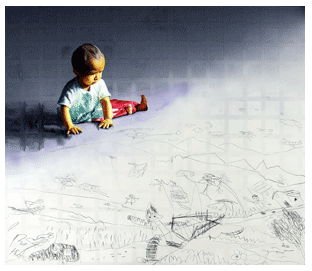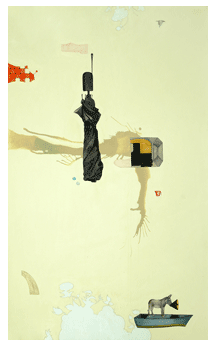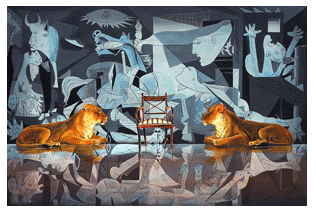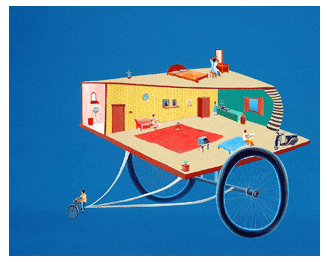- Prelude
- Guest Editor’s Column
- Hard Talk
- Eloquence of Silence
- The Age of Revivals: Gothic Revival Furniture
- Inkwell
- New Media : Living up to the chivalric code
- Universalizing Art through Individual Langue
- Speaking New Discourses
- Video Art of India- Gigi Scaria and his Videos
- Contemporary Trends of Sculpting
- In the News
- Artist Index and Statistics
- Market Insight
- Auction Reports
- The month that was
- Art Bengaluru
- Mumbai Artsighting
- Musings from Chennai
- Deccan Odyssey
- Delhi Dias
- In between – from Vadodara
- North-East Opsis
- A Tryst with Art in Madhya Pradesh
- Tradition and Beyond
- Reverie
- Indian (Sub) Way
- Creative Impulse
- Different hues of Aakriti
ART news & views
In between – from Vadodara
Volume: 2 Issue No: 8 Month: 9 Year: 2010
Young & Emerging
“Photography deals exquisitely with appearances, but nothing is what it appears to be.”- Duane Michals
Contemporary thinking today is popularly dominated by the photographic imagery. With the media bombarding hyper real imagery every second it's not wrong to say that we think photographically today.
Right from its inception photography has been influencing the art practice in varied ways. Though it was first rejected and contented as an art form it has slowly become the very raw material for art making today. In India the photographic references in art works can been seen from the early days of Indian modernist practice itself. But as a force to reckon within the market, it's in the 90's it was accepted within the art world for the quick sensations it created. For a period after its acceptance it did impact the art world tremendously. Images from newspapers, magazines and various other sources were traced, copied, photocopied, juxtaposed with other academic imageries, abstract forms and all combinations were transferred in the canvas/ paper etc. By blowing images through projectors or graphing on to the surface many artist's claimed for a photographic celebration in image making. This so called “mediatic realism” as a concept does suit the artistic practice as we see today. Though this theorization doesn't include interventions within photographic medium, it definitely succeeds in reporting the nature and depth of dominant art practice today.
it definitely succeeds in reporting the nature and depth of dominant art practice today.
The following set of artists has been majorly influenced by the photographic medium in their practice. These works in a way supplement the popular media's reportage of our contemporary life. These artists were selected in various Gen Next exhibitions till now.
Sandip Daptari's captures the popular sensitive moments of life like the photographs he refers to. His portrayals are problem free images of innocent children and people. The images are about delicate emotions and sensitive aspects of life. He also tries to raise questions about the inconsistencies and problems of people. He skillfully renders the photographic image as near to its copy /original as possible. The series of paintings, done on children tries to bring the innocent moments of children and the world as they see. By juxtaposing drawings which look like as done by the children he tries to enter their world and understand how it's structured.
Pappu Bardhan's imagery majorly plays with the idea of juxtaposing.  By juxtaposing different images he creates meanings which floats on the surface and requires the viewer to decipher them. His compositions may be referring to the understanding that juxtaposing divergent elements and fantastic forms would create a surrealistic image. Through these visually entertaining images he attempts to talk about the condition of the contemporary society and also some personal life. His compositions have very minimum elements in them and the background is generally left empty which adds to his way of expressing things
By juxtaposing different images he creates meanings which floats on the surface and requires the viewer to decipher them. His compositions may be referring to the understanding that juxtaposing divergent elements and fantastic forms would create a surrealistic image. Through these visually entertaining images he attempts to talk about the condition of the contemporary society and also some personal life. His compositions have very minimum elements in them and the background is generally left empty which adds to his way of expressing things
Barun chowdhury also talks about the contemporary existence and the problems common people are facing. His very skillfully and neatly crafted images are often about the people in general. These are about the events as they are unfolding through the media images. There is an interesting work by him where two lions are waiting near a chair. Background is the famous painting of Guernica by Picasso. One can also see the reflection of the same painting on the floor. If we read the lioness waiting for the seat as the present tussle for domination and authoritarian power, the representation of Guernica would remind us the gruesome violence of war and destruction of the past.  Obviously the continuing power struggles may lead to same war and destruction in future too.
Obviously the continuing power struggles may lead to same war and destruction in future too.
Debasish Dutta doesn't directly use photographic imagery in his works. His paintings are over crowed by people. They can be categorized in the general notion of mass. They are also about the contemporary way of life. Interestingly, he portrays the aspirations of the largely middle class society. Often a person is seen driving or pulling the structure like the urban apartments. One can possibly read it as the person driving and pulling along the dreams and aspirations as it is structured in our practices right from our childhood.  The desires which are created by the system through various mediums engage us in a race which we knowingly and many times unknowingly take part to fulfill the lack the desire creates in us. As known this desires are never to be fulfilled and just keep on reproducing further desires which is an unending process within this system.
The desires which are created by the system through various mediums engage us in a race which we knowingly and many times unknowingly take part to fulfill the lack the desire creates in us. As known this desires are never to be fulfilled and just keep on reproducing further desires which is an unending process within this system.
The common point on which these artists work converge is in their dependence on photographic imagery, though Debasish Dutta stands different in his way of drawing from this source. Their approaches reinstate the hegemonic rule of the photographic vision in the current artistic practices in India and elsewhere. The dependence on this photographic source needs to be critically analyzed for its use and the meanings it can produce today. Since many a times its wrongly understood as just transferring the image in painting medium from a photographic source. Such a resigned understanding without understanding the meaning of photographic image and its use in a different medium like painting has already done severe damage to the field. This understanding restricts such realisms to a labor oriented process alone without bringing any politics of image making.
Artist, Art Critic